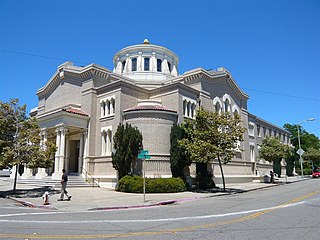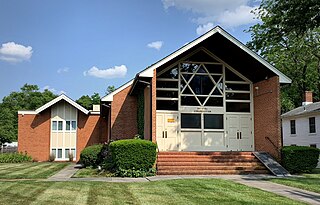
Agudath Israel Etz Ahayem, transliterated from Hebrew to mean the Congregation of Israel Tree of Life, is a Conservative Jewish synagogue located at 3525 Cloverdale Road in Montgomery, Alabama, in the United States.

Congregation Beth Elohim, also known as the Garfield Temple and the Eighth Avenue Temple, is a Reform Jewish congregation located at 274 Garfield Place and Eighth Avenue, in the Park Slope neighborhood of Brooklyn in New York City, United States.

Temple Sinai is a Reform synagogue located at 2808 Summit Street in Oakland, California, United States. Founded in 1875, it is the oldest Jewish congregation in the East San Francisco Bay region.

Congregation Beth Israel is an egalitarian Conservative synagogue and congregation located at 15 Jamesbury Drive in Worcester, Massachusetts, in the United States. Founded in 1924 as an Orthodox synagogue, the congregation formally affiliated with the United Synagogue of Conservative Judaism in 1949, and describes itself as the "leading Conservative congregation in Central Massachusetts."

Congregation Beth Israel Ner Tamid is an egalitarian Conservative synagogue located at 6880 North Green Bay Road in Glendale, a suburb north of Milwaukee, Wisconsin, in the United States.

Temple Beth Israel is a Reconstructionist synagogue located at 1175 East 29th Avenue in Eugene, Oregon, in the United States. Founded in the early 1930s as a Conservative congregation, Beth Israel was for many decades the only synagogue in Eugene.
Congregation Beth Israel is an egalitarian Conservative synagogue located at 989 West 28th Avenue in Vancouver, British Columbia. It was founded in 1925, but did not formally incorporate until 1932. Its first rabbi was Ben Zion Bokser, hired that year. He was succeeded the following year by Samuel Cass (1933–1941). Other rabbis included David Kogen (1946–1955), Bert Woythaler (1956–1963), and Wilfred Solomon, who served for decades starting in 1964.
Beth Israel Congregation is a Reform Jewish congregation located at 5315 Old Canton Road in Jackson, Mississippi, United States. Organized in 1860 by Jews of German background, it has always been, and remains, the only Jewish synagogue in Jackson. Beth Israel built the first synagogue in Mississippi in 1867, and, after it burned down, its 1874 replacement was at one time the oldest religious building in Jackson.

Congregation Beth Israel is a Jewish congregation located at 53 Lois Street in North Adams, Massachusetts. The congregation was founded in the early 1890s as House of Israel by Eastern European Jews recently immigrated to the United States. The Chevre Chai Odom congregation broke away from House of Israel in 1905, but re-united with it in 1958, and the congregation adopted its current name in 1961.

Congregation Beth Israel is a Reform synagogue and member of the Union for Reform Judaism located at 301 East Jefferson Street in Charlottesville, Virginia. Founded in 1882, it grew out of Charlottesville's Hebrew Benevolent Society, which was created in 1870.

Congregation Beth Israel is a Jewish congregation located at 10460 North 56th Street in Scottsdale, Arizona. Formally incorporated in 1920, it affiliated with the Reform Judaism in 1935.
Temple Beth Israel was a Reform synagogue located at 840 Highland Road in Sharon, Pennsylvania. Originally called House of Israel Congregation, it was founded in 1888 as an Orthodox congregation by Jews from Eastern Europe.
Temple Beth Israel is a Reform synagogue located at One Bowman Street in Plattsburgh, New York. Established in 1861, it served Plattsburgh's Jewish population and itinerant Jewish tradesmen in the region. After worshiping in temporary locations, the congregation acquired its first permanent home on Oak Street in 1866. Beth Israel adopted Reform services in 1910, and joined the Union for Reform Judaism in 1913.

Congregation Beth Israel is an independent, traditional egalitarian Jewish congregation, located at 229 Murdock Avenue in Asheville, North Carolina. Founded in 1899 as Bikur Cholim, it was an Orthodox breakaway from Asheville's existing synagogue. It hired its first full-time rabbi in 1909, opened a religious school in 1911, and acquired its first building, which burnt down in 1916, in 1913.

Beth Israel Congregation is a Conservative synagogue located at 265 North Avenue in Washington, Pennsylvania, in the United States. Founded in 1891, it was the first Jewish congregation in Washington County. Its first rabbi, Jacob Goldfarb, served for 50 years.
Congregation Beth Israel is a Jewish congregation located at 411 South Eighth Street in Lebanon, Pennsylvania. Founded in 1907 to provide services for the High Holidays, it was then, and remains today, the only synagogue in the Lebanon area.
Congregation Beth Israel is a Reform synagogue located at 615 Court Street in Honesdale, Pennsylvania. Founded in 1849 by German Jews, its 1856 synagogue building was the smallest in the United States. The congregation was originally Orthodox, but rapidly moved to "Classical Reform". In the 1930s and 1940s an influx of more traditional Eastern European Jews prompted a change from Classical Reform to Traditional Reform.
Congregation Beth Israel Judea is a Reform synagogue located at 625 Brotherhood Way in San Francisco, California. It is the result of the merger of the Conservative Congregation Beth Israel and the Reform Temple Judea.
Temple Israel is the oldest synagogue in Columbus, Ohio, and a founding member of the Union for Reform Judaism. Formed as early as 1846 as the Orthodox Bene Jeshurun congregation, its first religious leader was Simon Lazarus, a clothing merchant who founded what would become Lazarus department stores.

Beth El Congregation is a Reform Judaism congregation located at 520 Fairmont Avenue in Winchester, Virginia. The local Jewish community didn't develop until the late-19th century. They were mostly merchants and observed dietary laws, often having to travel to Baltimore for supplies. In 1908, the Jewish citizens decided to observe its first High Holy Days. Two local leaders learned shochet laws, enabling local Jews to keep kosher without having to travel out of town.













